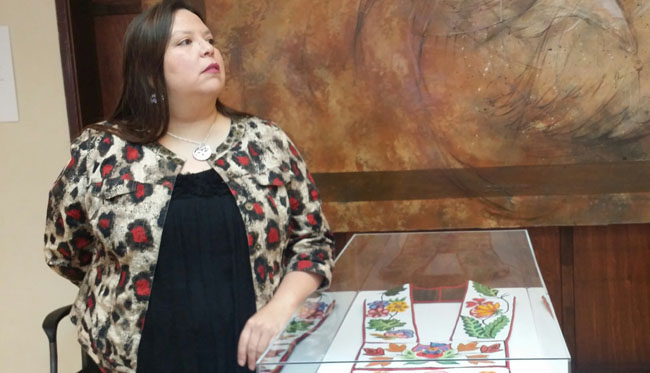Renowned bead work artist now teaching others


By Barbara Nahwegahbow
Naomi Smith is a collector, educator and a renowned bead work artist. Her skill with tiny glass beads that she says are called “Little Spirits” in some First Nations languages earned her a spot as a featured First Nations artist at the Vancouver 2010 Olympics. Smith is a citizen of Chippewas of Nawash Unceded First Nation.
“I did my first piece of beadwork when I was seven,” she said, “and I still have it. It’s really ugly.” Smith doesn’t seem capable of producing anything that’s not aesthetically pleasing. Beading was not only a cultural connection for Smith, “but it is it’s own form of expression,” she said, “you can say so much with it.”
Smith was part of the Sixties Scoop. “When I was taken away from my mother, I was eight weeks old,” she said, “and I was adopted out into a non-Native environment with a very nice, well-meaning non-Native family.” Smith was fortunate that her adopted parents taught her to be proud of her First Nations heritage. “If I wanted to pursue anything that was culture related, they always supported that,” said Smith. “They were always telling me, you’re special and you’re different.”
When she reconnected with her birth mother, Smith said it was like finding the final piece of the puzzle. “I found we were living parallel lives,” she said. “We liked the same things, used the same toothpaste and we both did beadwork and quillwork. It was like we were twins! That was a pinnacle moment in my life to learn more about who I was.” One of Smith’s most treasured possessions is a pair of her late mother’s moccasins, made and beaded by her mother. Wearing them, she said, is a special connection with her mother.
Smith began collecting vintage pieces of beadwork about fifteen years ago. “I wanted to know more about how they’re made,” she said. It’s a way for her to develop her own beading artistry. “I’ve always been creative”, she said. “I’m one of those people who can dissect something visually and figure out how it works. It’s part of my creative psyche to look at something and say, oh, I know how that’s done.”
Her first curatorial experience was an exhibition last year at Peel Art Gallery, Museum and Archives (PAMA) in Brampton. The exhibition, Spirit Seeds: A Celebration of First Nations Beadwork combined Smith’s collection of what she calls artifacts with contemporary bead work by Smith and other artists.
The exhibition was re-mounted again this past summer at the Native Canadian Centre in Toronto as part of the Aboriginal Pavilion Arts and Culture Festival. On display were elaborately beaded bags, strawberry pin cushions, picture frames and Iroquois smoking caps from the mid-1800s – mid 1900’s. Some of the items were made for the tourist trade while others were for family use.
“I’m just a custodian of these artifacts,” said Smith. “They tell a story about our people and our culture. I want people to understand that even though this is historical work, it is still very much a part of our culture and that the art form is living on.”
Smith’s role as an educator is important to her. Workshops provide a great opportunity, she said, to teach about the culture to both Indigenous and non-Indigenous people. An upcoming Moccasin Making Workshop at the Bata Shoe Museum is fully booked. “This helps to keep our art forms alive,” said Smith, “while allowing them to evolve.”


